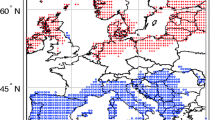Abstract
In this study, we have analyzed the spatial and temporal correlation between the North Atlantic Oscillation (NAO) and the climate in Iraq, with a focus on precipitation, temperature, and number of Mediterranean cyclones. It was found that the influence of the NAO varies per climate indicator. For example, the influence is greater on precipitation than on temperature. One conclusion of the study is that the mean annual precipitation in Iraq increases during a negative phase of the NAO and decreases during a positive phase. In addition, the correlation between NAO and precipitation is more pronounced in the south of the country than in the middle and northern regions.
Regarding the temporal correlation between NAO and precipitation, the influence of the NAO on Iraqi precipitation was found to be weak during the fall season, but to become more pronounced in the winter, culminating during the spring, and then vanishing in the summer.
It was also concluded that when the NAO is in a positive phase, the area featuring a desert climate (Bwha) expands in Iraq, while the area featuring other climates decreases. During these years, both the Mediterranean climate (Csa) and the steppe climate (Bsha) cover a smaller part of the country due to the limited amount of precipitation. The opposite occurs during a negative phase of the NAO.
Analysis of the number of Mediterranean cyclones that reach Iraq shows that there is no significant difference in the number of cyclones occurring during negative and positive phases of the NAO. However, there are differences in the strength of the cyclones.
This study represents a first step in analyzing the relation between the NAO and the Iraqi climate and hopes to lead to further research.







Similar content being viewed by others
Notes
Only three seasons are presented since summer season in Iraq is dry and no rain was recorded at the weather stations from June until end of September.
The precipitation season in Iraq starts in October and ends in May.
References
Ben-Gai T, Bitan A, Manes A, Alpert P, Kushnir Y (2001) Temperature and surface pressure anomalies in Israel and the North Atlantic Oscillation. Theor Appl Climatol 69:171–177
Cullen HM, Demenocal PB (2000) North Atlantic influence on Tigris–Euphrates streamflow. Int J Climatol R Meteorol Soc 20:853–863
Cullen HM, Kaplan A, Arkin PA, Demenocal PB (2002) Impact of the North Atlantic Oscillation on Middle Eastern climate and streamflow, Climatic Change, Kluwer Academic Publishers’, Printed In The Netherlands., 55, 315–338. http://balwois.com/balwois/administration/full_paper/ffp-465.pdf.
Fowler J, Cohen L, Phil Jarvis (1998) Practical statistics for field biology, second edition, John Wiley & Sons Ltd, printed in Britain.
Griffiths FJ (1994) Handbook of agricultural meteorology, Oxford University Press, printed in the U. S. A.
Hurrell JW (1995) Decadal trends in the North Atlantic Oscillation: regional temperatures and precipitation, Science, New Series, Vol. 269, No.5224, Aug.4, 676-679.
Hurrell JW, Kushnir Y, Ottersen G, Visbeck M (2003) The North Atlantic Oscillation: climatic significance and environmental impact, Geophysical Monograph 134, American Geophysical Union, printed in U.S.A.
Kücük M, Kahya E, Cengiz TM, Karaca M (2009) North Atlantic Oscillation influences on Turkish lake levels. Hydrol Process 23:893–906
Lamb PJ, and Peppler RA (1987) North Atlantic Oscillation: concept and an application, Bulletin American Meteorological Society, Vol. 68, No. 10, October, 1218-1225.
Marshall J, Kushnirb Y, Battistic D, Changd P, Czajaa A, Dicksone R, Hurrellf J, Mccartneyg M, Saravananf RA, Visbeckb M (2001) North Atlantic climate variability: phenomena, impacts and mechanisms. Int J Climatol R Meteorol Soc 21:1863–1898
Muñoz-Díaz D, Rodrigo FS (2004) Impacts of the North Atlantic Oscillation on the probability of dry and wet winters in Spain. Clim Res 4:33–43
Perry A (2000) The North Atlantic Oscillation: an enigmatic see-saw. Prog Phys Geogr 24(2):289–294
Rogerson AP (2011) Statistical methods for geography, third sedition, printed by TJ international. Padstow, Cornwall
Scaife AA, Folland CK, Alexander LV, Moberg A, Knight JR (2008) European climate extremes and the North Atlantic Oscillation. J Clim Am Meteorol Soc 21:72–83
Size B William (1987) Use and abuse of statistical methods in the earth sciences, Oxford University Press
Strahler A, Strahler A (2005) Physical geography science and systems of the human environment, third edition, John Wiley and Sons, Inc., printed in U.S.A.
Uvo CB (2003) Analysis and regionalization of northern European winter precipitation based on its relationship with the North Atlantic Oscillation. Int J Climatol 23:1185–1194
Author information
Authors and Affiliations
Corresponding author
Rights and permissions
About this article
Cite this article
Khidher, S.A., Pilesjö, P. The effect of the North Atlantic Oscillation on the Iraqi climate 1982–2000. Theor Appl Climatol 122, 771–782 (2015). https://doi.org/10.1007/s00704-014-1327-4
Received:
Accepted:
Published:
Issue Date:
DOI: https://doi.org/10.1007/s00704-014-1327-4




